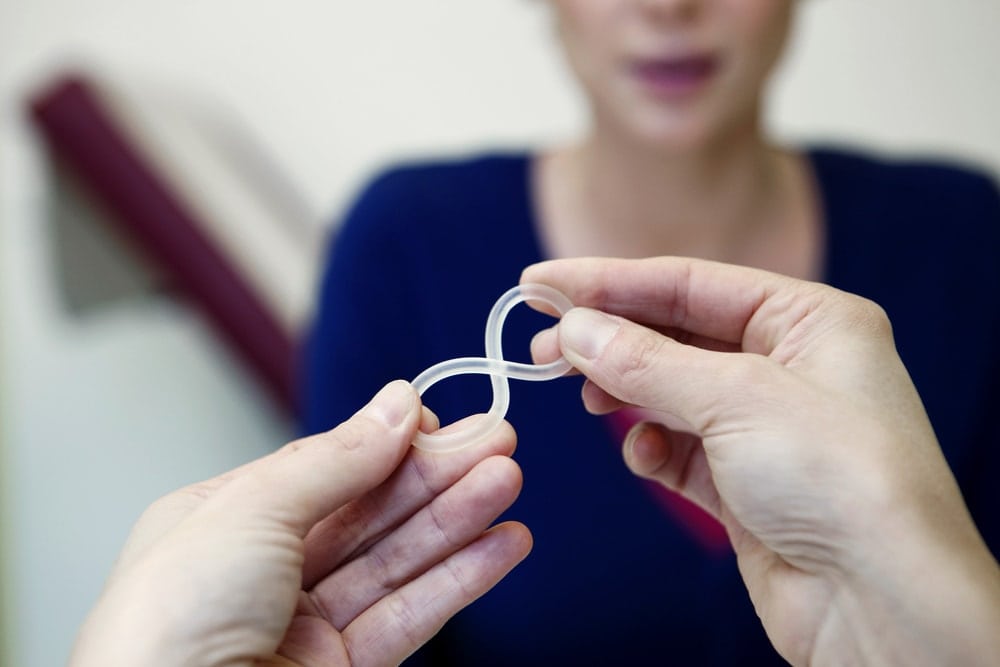The vaginal ring is a soft, flexible piece of plastic that contains synthetic hormones to be absorbed inside the vagina. It is a hormonal method of contraception obtained by prescription. These hormones help regulate your fertility in a similar way to how natural hormones work.
The vaginal ring prevents pregnancy in one of three ways:
- First, it prevents eggs from being released from the ovaries.
- Second, it thickens the cervical mucus, preventing the sperm from reaching the egg.
- Third, it changes the lining of the uterus, preventing implantation. This third method presents some ethical concerns that you may want to consider.
How Do You Use the Vaginal Ring and How Effective is It?
The device is inserted into your vagina where it remains for three weeks. It is removed during the fourth week to allow your menstrual period to occur. At the end of the fourth week, the process is repeated. The vaginal ring begins to work immediately, but a second form of birth control should be used during the first seven days of your first month’s use of the vaginal ring.
The failure rate is less than 2% when it is used correctly and consistently. In other words, when it is used correctly, less than 2 in 100 women will get pregnant. You should take a pregnancy test if you are experiencing pregnancy symptoms.
Certain medications and supplements can also reduce the effectiveness of the vaginal ring. These include:
- St. John’s wort
- the antibiotic rifampin
- some HIV medications
- some antiseizure medications
If you take any of these, it’s a good idea to use a backup form of birth control.
What are the Side Effects or Health Risks of the Vaginal Ring?
The device has side effects similar to those experienced by users of oral contraceptives or other hormonal types of contraception which include:
- Headaches
- Dizziness
- Nausea
- Breast tenderness
- Fatigue
- Moderate weight gain
- Change of appetite
Additional side effects may include vaginal bleeding, skin irritation, yeast infections, contact lens problems, and depression.
The device should not be used by women who:
- Smoke
- Have high blood pressure
- Have a history of breast or uterine cancer
- Have a history of blood clots
- Have a history of heart attack or stroke
- Are allergic to hormones
- Have diabetes
- Have liver disease
- Have unexplained vaginal bleeding.
Contact your healthcare provider immediately if you experience any of the following:
- Chest pains
- Redness, swelling, or pain in your legs
- Abnormal or irregular vaginal bleeding
- Jaundice (yellowing of the skin)
- If you think you might be pregnant
Women who wish to use the vaginal ring should seek additional consultation with their physician if they are experiencing any of the following medical concerns:
- Depression
- Diabetes
- High blood pressure
- High risk for heart disease
- History of blood clotting conditions
- History of liver disease
Is the vaginal ring reversible?
Yes. Ovulation may return within a few days after discontinuing the ring; however, it may take a few months for some women. Pregnancy should be possible when you stop using the vaginal ring.
What about the risks of sexually transmitted diseases (STDs)?
The vaginal ring does NOT provide protection against the transmission of sexually transmitted diseases.
Can I use the vaginal ring when I am breastfeeding?
If you have recently been pregnant or if you are breastfeeding, it is best to consult your physician for the best time to start using the ring.
What do I do if the ring comes out?
If the ring comes out, it is best to replace it right away. If you do this within 3 hours, no backup method should be necessary.
Where does the ring need to go?
The exact position of the ring in the vagina is not vital to its effectiveness but read your instructions carefully to understand where the ring should be placed.
The Pros of the Vaginal Ring:
- Highly effective when used correctly
- Does not inhibit sexual spontaneity
- Minimal side effects
- You do not have to remember to take a pill each day.
- You do not have to go to the doctor’s office for a shot each month.
- It is reversible.
The Cons include:
- Does NOT protect against sexually transmitted diseases
- Requires a prescription
- Requires monthly insertion and removal
Want to Know More?
Sources
- Centers for Disease Control (CDC): Birth Control Methods
- Healthline






